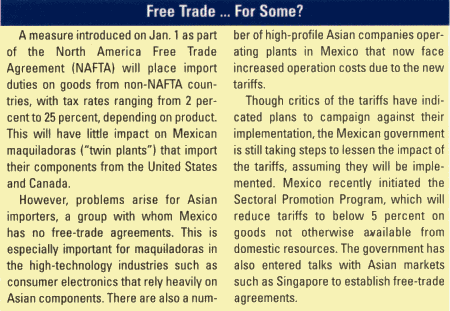W |
hat a difference a few years can make. Ten years ago, Mexico, by most accounts, was a third-world country. But since the opening of North American trade through NAFTA (North American Free Trade Agreement), Mexico has become a fast-growing economy and a much-sought-after spot for corporate locations.
In fact, Mexico ranks as the No. 1 destination for U.S. foreign direct investment, according to the latest FDI Confidence Index, a report provided by global management consulting firm A.T. Kearney (www.atkearney.com). Mexico’s overall investor attractiveness jumped two spots from No. 7 a year ago to today’s No. 5 — representing the most positive change in outlook among executives over the last year by A.T. Kearney standards.
Now Mexico’s economy is entering yet another era of expansion under the leadership of President Vicente Fox. As the first leader to knock the long-ruling Institutional Revolutionary Party (PRI) out of the presidential office, Fox has hit the ground running. With hopes of making Mexico an independent economic powerhouse, Fox has promised to double the amount of foreign direct investment inflow and to create 1.3 million new jobs a year during his time in office.
There are concerns, however. Fox faces similar problems to those of the new U.S. president: He is trying to set himself apart from the former administration, but many question his lack of experience. Two of the biggest challenges facing the new president, according to investors surveyed by A.T. Kearney, are economic stability and political reform.
New President Introduces New Economic Program
Fox, however, has already taken steps to move the country forward. One of the efforts was choosing his cabinet. His choices have won him high acclaim, according to PricewaterhouseCoopers Global (www.pwcglobal.com), which reported in its latest International Briefings that the cabinet members have been “broadly welcomed both domestically and internationally” by business leaders.
Within his first month in office, Fox’s 2001 budget was approved unanimously by Congress, setting what many analysts are calling realistic goals for the country. “This has never happened before, not even when the PRI had complete domination over things,” said Fox in a recent interview with the Financial Times, London. “It has also been the first political transition in Mexico without a crisis or anything untoward. There has been great economic stability, and we are going to maintain it.”
The fiscal policy passed by Congress will reduce the fiscal deficit to .65 percent, but Fox hopes to reach a .5 percent deficit. Congress set the real gross domestic product growth rate at 4.5 percent, and the inflation rate should grow no larger than 6.5 percent — down from 9 percent in 2000. In March, Fox brought to Congress two major pieces of legislation for consideration: one that calls for more fiscal reform and one for tax reform. Included in the tax reform is an extension of the 15 percent value-added tax to food and medicines.

Mexico is also following the lead of its northern neighbor by modernizing government operations. Fox expects that by year’s end, many areas of the government will be certified according to ISO9000 standards.
Fox is moving toward more free trade agreements in order to create alternative sources of investment and to combat potential sluggish growth due to a slowing U.S. economy. Mexico will soon begin trading with Europe under the new European Free Trade Agreement. In January, Fox went to the World Economic Forum in Davos, Switzerland, and later visited hundreds of companies in Frankfurt, Germany, and Milan as part of his efforts to expand Mexico’s investor base.
www.pwcglobal.com”There is a great enthusiasm about the possibility of investing in Mexico to get access to the U.S. market without tariffs, as well as to invest in Mexico and export back to Europe,” Fox told the Financial Times. “This is a unique situation. No other country in the world has this advantage.”

